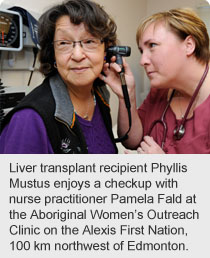
January 24, 2013
Going to the doctor’s used to be a draggy, drawn-out affair for Phyllis Mustus.
 Right off the top, there would be the hour’s drive each way to Barrhead or Edmonton, then more hours spent in medical waiting rooms or labs, often simply to request paperwork or a blood test. In the winter, icy highways could dangerously complicate matters further.
Right off the top, there would be the hour’s drive each way to Barrhead or Edmonton, then more hours spent in medical waiting rooms or labs, often simply to request paperwork or a blood test. In the winter, icy highways could dangerously complicate matters further.
“It could easily eat up my entire day,” she says. “I couldn’t plan on anything else.”
Today, the Alexis First Nations elder simply walks to see her nurse practitioner at the Aboriginal Women’s Outreach Clinic close to her home — and she loves it.
“I had a liver transplant over 10 years ago,” says the 63-year-old. “I have to have monthly blood work. She does it right here and shows me my results. When I have issues, I can just go to her. She does referrals right away if I need them. I don’t have to go to see my family doctor in Barrhead, almost an hour away, just to ask for a referral. She saves me all that travel. It’s very convenient.”
Aboriginal women of the Alexis and Paul First Nations now enjoy more comprehensive health care close to home thanks to two new on-reserve clinics developed through a partnership between Alberta Health Services (AHS), Health Canada, WestView Primary Care Network and First Nations communities.
Now marking their first anniversary, these Aboriginal Women’s Outreach Clinics — led by WestView Health Centre-based nurse practitioner Pamela Fald — have greatly boosted access to primary care and eliminated transportation obstacles for many patients.
“The greatest thing about this is that women can receive care in their own community,” says WestView nurse practitioner Kathy Romaniuk-Verge, who helped to create and organize the clinics. “They don’t have to travel, sometimes an hour, to get to their family physician. They can walk to our clinic from their home. It’s a one-stop shop for women’s health.”
Among the services available at the clinic: annual Pap screenings; diagnostic testing; screenings for sexually transmitted infections (STIs); health assessments; renewing or initiating new prescriptions; and referrals for ultrasounds, X-rays, minor surgical procedures and birth control.
Prenatal care is also an important focus of the clinics.
“Each community has a prenatal registry. When a women registers, often the community nurses will suggest she visit our clinic for all the necessary bloodwork,” says Fald. “We ask: Do they have a doctor? Have they had an ultrasound? We take that second look and make sure moms-to-be are linked up with the appropriate care providers, and that they have everything they need.”
The full-day clinics alternate Wednesdays between the Alexis First Nation, 65 km northwest of Stony Plain, and the Paul First Nation, 25 km west of Stony Plain. On any given clinic day, six to 10 women visit their band health unit to see the nurse practitioner.
The clinics collaborate and share information with the women’s family physicians and their other care providers to ensure continuity of care.
“This is an example of true partnership to increase access to primary health services for Aboriginal women,” says Ellen Billay, Site Director of WestView Health Centre. “We have been able to work together to establish a program that really enables women to access quality health service in a timely and effective manner.”
Barb Paul, director of Alexis Health Centre, says she’s grateful these primary care services are now available in her community.
“We’re already seeing more walk-ins and faster referrals, and we really appreciate how WestView Primary Care Network has reached out to improve medical services here,” Paul says.
Marie Bird, acting director of Paul First Nation Health and Community Wellness Centre, adds the clinic is bridging the gap between women’s health issues and access to services.
“The nurse practitioner is building trust and rapport with our members,” says Bird. “This service is a blessing to the women of Paul First Nation.”
Word of the clinic is spreading through both communities.
“The thing I like most is being able to connect with women to provide a service that is sometimes very difficult for them to access on their own,” says Fald, “I like developing the relationships and building the trust with my patients; now I’m seeing their sisters and their mothers and their children.”
Herman Wierenga, Health Canada’s Regional Executive for First Nations and Inuit Health Branch, says he is proud to be part of this initiative.
“This demonstrates both the strong relationship we have with our provincial counterparts, and our commitment to First Nations health care,” says Wierenga.
Mustus says she trusts and appreciates the expertise her nurse practitioner.
“Pam usually has a ready answer for all my health questions. I feel like I’m in good hands when I come to see her. The clinic has really made a big difference here.”